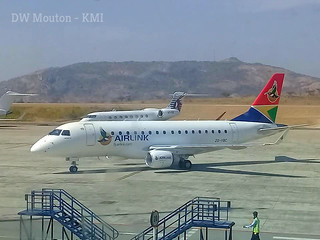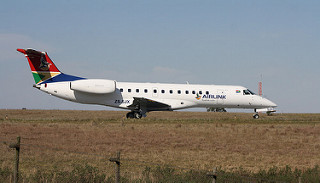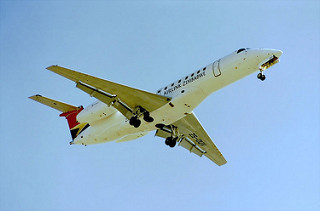SA Airlink RJ85 at Johannesburg on Mar 27th 2019, engine shut down in flight
Last Update: August 4, 2020 / 20:09:34 GMT/Zulu time
Incident Facts
Date of incident
Mar 27, 2018
Classification
Report
Airline
SA Airlink
Flight number
SA-8769
Departure
Johannesburg, South Africa
Destination
Upington, South Africa
Aircraft Registration
ZS-SSJ
Aircraft Type
AVRO RJ-85 Avroliner
ICAO Type Designator
RJ85
South Africa's Civil Aviation Authority (SACAA) released their preliminary report stating the engine failed while delivering 90% N1 climb thrust. The cause of the failure is not yet known. The engine had accumulated 25 579.28 hours since new and 230.28 hours since the last engine shop visit on Aug 10th 2018.
On Aug 4th 2020 SACAA released their final report concluding the probable cause of the serious incident was:
The number 4 engine failure was due to the failure of one of the first stage compressor blades, likely caused by a fatigue crack at the root of the blade.
The SACAA analysed:
The aircraft, a British Aerospace Avro 146-RJ85, was powered by four Honeywell LF507-1F turbofan engines. The number 4 engine was installed in the number 4 position on 10 December 2018 at a total engine time of 25 349.12 hours and 19 972 engine cycles. At the time of the serious incident, the engine had accumulated a total of 25 579.28 hours and 20 148 cycles. The engine had been in service for 230.16 hours and 176 cycles following maintenance intervention from an approved engine overhaul facility on 10 August 2018.
All applicable Airworthiness Directives (AD) and Service Bulletins (SB) were reviewed and were found to have been carried out as required.
The last borescope inspection on this engine was carried out in June 2015 and the failed engine had operated for 4443, 28 hours since the last borescope inspection. The borescope inspection limits require that it should be carried out at every 6000 hours initially, and subsequently, at every 3000 hours. The borescope conducted in June 2015 resulted in the replacement of the LP compressor blades on the number 4 engine. The engine was due for a borescope after an additional 1556. 72 hours, thus, it was still within its limits.
The blades have a life limit of 50 000 flying hours (FH) and 25 000 cycles; and the failed blades had accumulated 4443,28 hours and 2333 cycles, thus, they were not due to be changed yet.
According to the engine condition report, the first stage compressor blades were fitted new at the IC-03 on 9 June 2015 at 21 136 hours and 17 815 engine cycles. The first stage compressor blades accumulated a total of 4443.28 hours and 2333 cycles before one of the blades failed.
The first stage compressor blades were inspected according to Honeywell Service Bulletin ALF/LF-72-1105 during the last shop visit on 10 August 2018 at 25 349.12 hours and 19 972 engine cycles. No defects were recorded during the inspection. The blades had operated for a further 230.16 hours since the last shop visit and 4443.28 hours since their fitment to this engine.
The aircraft was fitted with a Honeywell D-FDR. The unit was downloaded by an approved facility. From the data, the number 4 engine N1 suddenly spooled down at the same time the aircraft lateral accelerometer recorded an instantaneous increase in vibration levels from 0.008 to 0.115 units for a short time.
The investigation revealed that the serious incident occurred because of failure of one of the first stage compressor blades which had cracked at the root before it separated. The blade travelled to the rear of the compressor section, damaging the LP and HP compressors and some internal engine components in the compressor section of the engine.
The first stage compressor blade failed at 230.16 hours following the last shop visit where the compressor section was inspected; no defects were noted during that inspection. It is likely that the crack on the blade root was due to fatigue given that it failed at 230.16 hours after the last shop visit.
Incident Facts
Date of incident
Mar 27, 2018
Classification
Report
Airline
SA Airlink
Flight number
SA-8769
Departure
Johannesburg, South Africa
Destination
Upington, South Africa
Aircraft Registration
ZS-SSJ
Aircraft Type
AVRO RJ-85 Avroliner
ICAO Type Designator
RJ85
This article is published under license from Avherald.com. © of text by Avherald.com.
Article source
You can read 2 more free articles without a subscription.
Subscribe now and continue reading without any limits!
Read unlimited articles and receive our daily update briefing. Gain better insights into what is happening in commercial aviation safety.
Send tip
Support AeroInside by sending a small tip amount.
Related articles
SA Airlink RJ85 near Pietermaritzburg on May 18th 2016, engine shut down in flight
An SA Airlink Avro RJ-85, registration ZS-SSJ performing flight 4Z-8730/SA-8730 from Pietermaritzburg to Johannesburg (South Africa), had just…
SA Airlink RJ85 at Johannesburg on Jul 26th 2015, hydraulic failure
A South African Airlink Avro RJ-85, registration ZS-SSJ performing flight 4Z-8845/SA-8845 from Johannesburg to Nelspruit (South Africa), was climbing…
SA Airlink RJ85 at Cape Town on Oct 9th 2019, engine fire indication
A South African Airlines Avro RJ-85, registration ZS-TCP performing flight SA-8604 from Cape Town (South Africa) to Maun (Botswana) with 12…
SA Airlink E170 at Harare on Jan 13th 2021, bird strike
An SA Airlink Embraer ERJ-170, registration ZS-YBC performing flight 4Z-103 from Harare to Johannesburg (South Africa), was climbing out of Harare's…
SA Airlink E170 at Kimberley on Jan 23rd 2020, bird strike
A South African Airlink Embraer ERJ-170 on behalf of SAA South African Airways, registration ZS-YBC performing flight SA-8428 from Kimberley to…
SA Airlink E135 at Kasane on Feb 26th 2019, bird strike
A South African Airlink Embraer ERJ-135, registration ZS-SJX performing flight 4Z-8307/SA-8307 from Kasane (Botswana) to Johannesburg (South Africa),…
SA Airlink E135 near Windhoek on Jan 28th 2019, cabin did not pressurize
A South African Airlink Embraer ERJ-135, registration ZS-OUV performing flight 4Z-8127 from Windhoek (Namibia) to Cape Town (South Africa) with about…
Newest articles
Emirates A388 at Auckland on Nov 30th 2025, tyre and wheel damage on landing
An Emirates Airbus A380-800, registration A6-EUE performing flight EK-448 (dep Nov 29th) from Dubai (United Arab Emirates) to Auckland (New Zealand),…
Arabia Maroc A320 at Nador on Nov 30th 2025, runway excursion
An Air Arabia Maroc Airbus A320-200, registration CN-NMH performing flight 3O-122 from Amsterdam (Netherlands) to Nador (Morocco), landed on Nador's…
Subscribe today
Are you researching aviation incidents? Get access to AeroInside Insights, unlimited read access and receive the daily newsletter.
Pick your plan and subscribePartner

ELITE Simulation Solutions is a leading global provider of Flight Simulation Training Devices, IFR training software as well as flight controls and related services. Find out more.
SafetyScan Pro provides streamlined access to thousands of aviation accident reports. Tailored for your safety management efforts. Book your demo today
AeroInside Blog
Popular aircraft
Airbus A320Boeing 737-800
Boeing 737-800 MAX
Popular airlines
American AirlinesUnited
Delta
Air Canada
Lufthansa
British Airways




